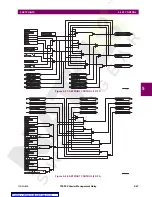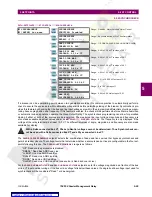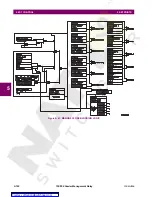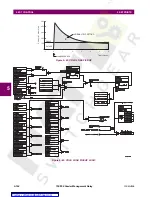
5-108
750/760 Feeder Management Relay
GE Multilin
5.8 S7 CONTROL
5 SETPOINTS
5
After the lost source has been reestablished, the scheme provides three methods to restore the system to normal configu-
ration, two manual and one automatic. If the sources cannot be synchronized, the bus tie breaker must be manually
opened before the open incomer can be manually closed. In this procedure the incomer will only be allowed to close if the
incoming source (Line VT) voltage is above a live threshold and the load (Bus VT) voltage is below a dead threshold value.
If the sources are synchronized with synchrocheck supervision, it is possible to manually close the open incomer to parallel
all three breakers. The scheme will then automatically open a breaker that had been previously selected to trip if all three
breakers become closed. In this instance, the bus tie breaker is ‘Selected To Trip’ and will open. The automatic method of
returning the system to normal configuration uses the undervoltage tripped portion of the restoration scheme.
In addition to the relay required for each of the three circuit breakers, it is required to connect one contact from a three-posi-
tion switch to each relay. This switch (Device 43/10) is used to select the breaker that will trip after all breakers become
closed. It is also recommended that a two-position switch (Device 43/83) with three contacts be connected to each relay as
an “Auto-Off” transfer scheme selector.
Because a relay is required on the bus tie breaker, it allows bus-splitting operation. This is accomplished by setting the time
overcurrent elements in the relay on the bus tie breaker to trip faster than the incomers, opening the bus tie before an
incomer when operating from only one source.
The scheme can be used in conjunction with both non-drawout and drawout switchgear. Drawout switchgear designs can
make use of an auxiliary switch that confirms that the monitored breaker is in the "Connected" position, and is therefore
ready for operation. Fixed breaker installations can use contacts on the associated isolating disconnect switches (if avail-
able) for this purpose. The scheme design can be applied to:
1.
Substations with no signaling from upstream equipment.
2.
Substations with an upstream circuit breaker equipped with a trip signal (Device 94).
3.
Substations with a source transformer and transformer fault detection signal (Device 86T).
4.
Both 1 and 2 above.
The only differences in implementing the transfer scheme among the configurations presented above is by connecting
additional logic signals to the relay when available and by placing a jumper on one logic input if the breaker is non-drawout
and has no disconnect auxiliary switches.
Besides the setpoints and logic incorporated into the transfer scheme, the relays make use of some or all of the logic
inputs, phase instantaneous (Device 50P-1 or 2), neutral overcurrent (Device 50N-1 or 2), both line undervoltage elements
(Devices 27-3 and 27-4), and the synchrocheck (Device 25) features of the relays.
The following discussion is based on Configuration 4 above, using drawout breakers. Schematic diagrams of the DC con-
nections required by an example scheme with this configuration are presented in the schematics on pages 5–112 to 5–114.
Logic for each relay of the scheme is presented in the logic diagrams on pages 5–115 to 5–117. Connections that are not
required for configurations other than Configuration 3 above are indicated as “optional” on the schematic diagrams.
All connections for AC voltage and current are outlined in Chapter 3. The scheme design requires that the AC volt-
age connections for ‘Line’ and ‘Bus’ sources on the incomer relays be in accordance with Figure 5–66: Transfer
Scheme One Line Diagram on page 5–111 regardless of configuration. The connection of AC voltage to the relay
on the bus tie does not affect operation of the scheme,
but
the connection to the line voltage input terminals must
be a phase-phase voltage.
For the following discussion assume that Source 1 is the failed side. Identical logic with all 1s and 2s interchanged applies
to Relay 2 for a loss of Source 2. A transfer (trip of Incomer 1 followed by Bus Tie closing) from Relay 1 can be initiated by:
•
Operation of transformer 1 lockout relay (Device 86T1).
•
Operation of the Source 1 breaker auxiliary trip device (Device 94-1).
•
Time out of Relay 1 line voltage inverse time undervoltage element (Device 27-4) caused by low voltage on Source 1.
A transfer initiation is blocked if:
•
Any of the three breakers is not in the connected state.
•
Incoming Breaker 2 (which is to become the new source) is presently open.
•
An overcurrent condition on Bus 1 is detected by Devices 50P-1 or 2 or 50N-1 or 2, to prevent a faulted bus from being
transferred to a healthy source.
•
The line definite time Undervoltage element (Device 27-3) on Source 2 is operated, indicating low voltage on the other
source.
N
OTE
















































